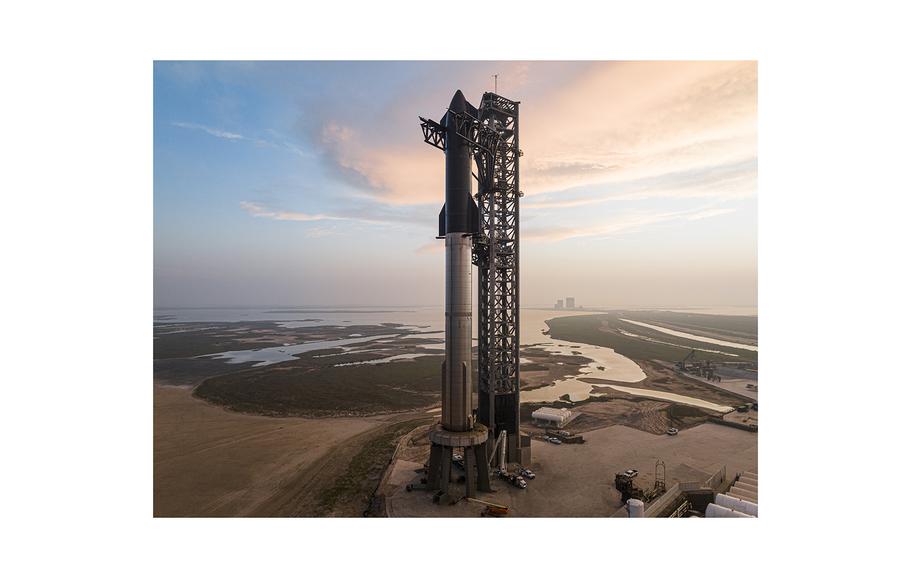
Starship test flight mission. (SpaceX/Flickr)
COCOA (Tribune News Service) — If SpaceX’s Starship and Super Heavy ever finds a home on the Space Coast, what would be the most powerful orbital rocket to ever launch from here is going to have an environmental impact.
For a pair of potential sites within Cape Canaveral Space Force Station, the process to figure out exactly what that is has begun, including a set of in-person and virtual meetings for the public to comment on concerns about frequent launches of a rocket twice as powerful as the Saturn V rockets from the Apollo program.
The first of those public meetings brought out a few hundred curious residents to the Catherine Schweinsberg Rood Central Cocoa Library on Tuesday night.
“The point of these meetings today and this week is to get as many members of the public — it can be any members of the public: residents, researchers, teachers, it really doesn’t matter, everyone — to come here, in person or online or email their comments, concerns, questions, pretty much anything about this process,” said Emre Kelly, media operations chief for Space Launch Delta 45, the Space Force group that oversees the launch sites.
The meetings are the first step in what is expected to be about a 15-month process to complete an Environment Impact Statement, headed up by the Department of the Air Force. The Space Force falls under the Air Force the same way the Marines fall under the Navy.
The goal of the EIC, which was announced in February, is to determine whether the Air Force will go into a lease agreement to take over the existing Space Launch Complex 37, create a new Space Launch Complex 50 or do nothing.
SLC 37 is currently home to United Launch Alliance’s Delta IV Heavy launches, but the last of those rockets is slated to fly by this summer, after which ULA is expected to give up its lease on the launch site. A new SLC 50 would be on currently undeveloped land between SLC 40, where SpaceX launches Falcon 9 rockets, and SLC 37.
Instead of a set of speakers talking about the various aspects of the program’s environmental impact, representatives from the Space Force, Federal Aviation Administration, NASA and the Coast Guard were stationed around placards describing the where, why and next steps in the environmental impact evaluation process.
Members of the public wandered in at a pretty steady stream during the three-hour event to ask questions about the plans.
“They have a lot of work to do,” said John Boerlin who came with his two adult sons Tom and Greg, all from Merritt Island. “I expected probably more detail about the vehicle and that kind of stuff, but it’s early.”
“I’m feel good about it,” Tom added, noting he sleeps through the more frequent sonic booms SpaceX’s current rocket launches sometimes produce. “I think SpaceX has a good record. I think if anyone can build a big rocket like that successfully, right now, they’re ahead of the game. So I don’t see any problems.”
The second meeting tonight, March 6, is from 4 to 7 p.m. at the Titusville Civic Center followed by Thursday, March 7, from 4 to 7 p.m. at the Radisson Resort at The Port in Cape Canaveral. A virtual meeting is also planned on March 12 that will be recorded and available through March 22, according to the website at spaceforcestarshipeis.com.
Anyone on site is able to leave written comments or get access to leave them online. Comment will be incorporated into the draft version of the EIS that is targeting release in December.
“Then there are more meetings again after that,” Kelly said. “So obviously, it’s incredibly important that anyone who has any thoughts about this officially comments, and they don’t have to give their name or address or anything like that. Obviously, the important thing to note, it’s public record once they do.”
The final version of the EIC, which is the most intensive regulatory watchdog option under the National Environmental Policy Act, is targeting release in summer 2025 with the preferred launch site alternative. Only after that could SpaceX venture into any sort of new launch site agreement.
SpaceX for now uses its Starbase launch site in Boca Chica, Texas, for its Starship and Super Heavy launch attempts. The rocket can generate more than 17 million pounds of thrust on liftoff.
The first two in 2023 ended explosively, although the last in November did manage to technically make it to space. A third attempt is awaiting FAA approval to launch and could come later this month.
SpaceX had been building out a launch tower to support Starship launches from Kennedy Space Center’s Launch Pad 39-A as well, but the company has stated that its launch plans dictate multiple launch sites to support hundreds and then thousands of Starship launches a year.
So while the KSC launch pad may eventually see Starship as well, that’s up to NASA. This EIC is specifically tailored for Cape Canaveral Space Force Station.
“This is between Air Force/Space Force and SpaceX,” Kelly said.
©2024 Orlando Sentinel.
Visit orlandosentinel.com
Distributed by Tribune Content Agency, LLC.